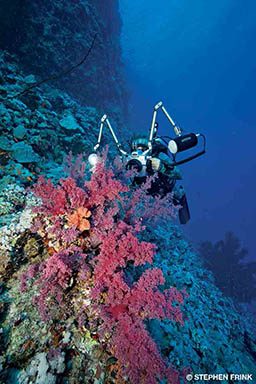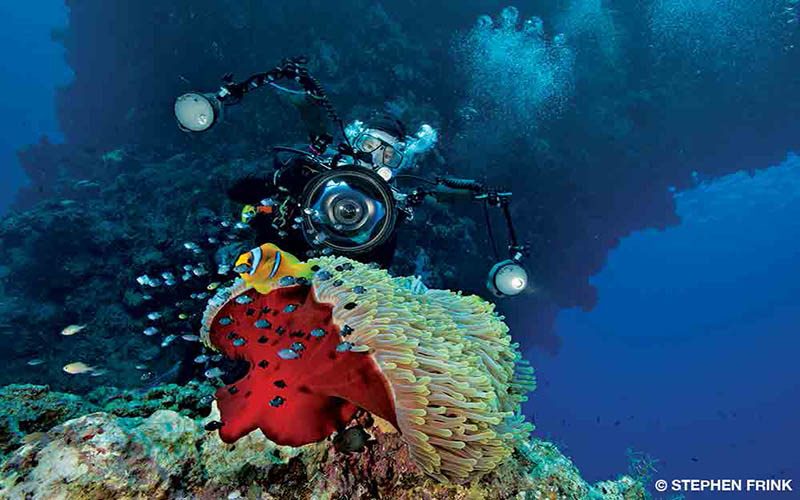Underwater photography, for me, was an evolution of my passion for topside photography. I suspect most aficionados, however, first became scuba divers and then embraced underwater stills and video to record and share the wonders of the underwater world. Along the way, these divers would have refined their diving skills, either consciously or subconsciously, to become more adept at moving through the water while handling unwieldy photography gear. In-water skills are important for productive interactions with often elusive marine life. Here are a few tips that may accelerate the learning curve.
Dive Gear
While most modern dive gear is very good and will serve the underwater photographer well, a few features might make the task easier.

- Mask — The mask is probably the most significant piece of personal gear because it’s important to both see your subject clearly and have an unobstructed view through your camera housing’s viewfinder. For the same reason Ansel Adams draped a black cloth over his head while focusing on the ground glass of his view camera while in the field, an underwater photographer will likely prefer a low-volume mask with a black skirt. The low volume gets the eye closer to the viewfinder so the frame can be viewed at a single glance, preferably edge to edge, and the black skirt blocks extraneous light. A clear silicone mask lets in so much light that the contrast in the viewfinder glass is diminished, and detail is more difficult to discern. (Masks with side windows to enhance peripheral vision have the same problem.) A mask that doesn’t leak is crucial as well.
- Regulator — Ease of breathing is important, of course, but subtle perks can make a regulator better suited for underwater photography. A regulator that exhausts completely to the side prevents bubbles from percolating in front of the housing and interfering with vision. I prefer a regulator with a knob to adjust breathing resistance according to the task. Exhaust bubbles can ruin the shot if I am shooting an overhead subject, so the ability to briefly hold my breath without the regulator trickling gas is important. For that task I’d increase breathing resistance. When I need more airflow while exerting myself — in hot pursuit of a turtle, for example, or in a similar situation — the ability to decrease resistance makes breathing more comfortable.
- Buoyancy compensator — A buoyancy compensator (BC) with the wings in the back minimizes the volume along the front of the torso, which is useful when getting through tight places on the reef or on wrecks. Because underwater photography often requires travel, I try to find a lighter BC that still offers reasonable lift and durability. I prefer fewer hoses, so I like an inflator/regulator, which eliminates the traditional spare second stage from my kit and allows me to breathe from it in an emergency while sharing my primary with another diver. The integrated inflator concept is de rigueur for a photographer whose hands are otherwise occupied with camera gear.
- Wetsuit — I’m very picky about my wetsuits. While waiting for marine-life behavior to present, underwater photographers tend not to move as much as the average recreational diver. Consequently, it is easier to get cold, so good thermal protection is a must. An old and compressed suit has diminished efficiency and should be replaced. Modern wetsuits are wonders of technology, but they can’t be expected to last forever. For tropical diving, my 3mm suits get a lot of use, and I tend to replace them annually.
-
Fins — I’ll use different fins for different tasks. For freediving I like long-bladed performance fins (mine have carbon-fiber blades) to allow me to get closer to deep-diving marine life such as whales or dolphins. For reef diving I prefer a fin that helps me navigate around fragile corals with precision and provides sufficient thrust when in currents. Fins are an exceedingly personal decision, so whether split fins or paddle fins, full foot or open heel, there are many variables in determining the right one for each use.
- This observation became abundantly clear to me when split fins had just come out and I suggested in print they were not good for underwater photography. It was a stupid thing to say because I had dived with only one particular split fin, and it turned out it had been designed as a snorkel fin. Photographers’ housings and strobes contribute resistance to water, so a more powerful fin is generally preferable, and that fin was not the one for me.
- Pete McCarthy, the owner of a patent on split-fin technology, was gracious though. He saw the article, called me to explain how I had it wrong and sent me a dozen pairs of split fins by various manufacturers. They all had licensed the Nature’s Wing technology but used it in different ways. Some were full foot; others were open heel. Some had stiff blades; others were flexible. The vents and the rails varied, and each performed differently in the water. Compared to the teams that design dive gear, I knew very little and had no justification for pontificating. There are such profound differences in fin performance that it may take a while to find the one that best suits your needs.

Dive Skills
Any skilled scuba diver can take on the challenges of underwater photography. Once the life-support aspect of scuba becomes more autonomic, it is not that difficult to take on another task, but success in underwater photography is certainly facilitated by in-water control.

- Buoyancy — Proper buoyancy is important not only for personal comfort and safety but also to avoid contact with fragile corals. Photography requires proximity, and proximity bears risk to delicate reef structures. The ability to hover near the reef without contact is crucial. Using small inhalations to slightly rise and exhalations to sink is important. I typically choose to be somewhat negatively buoyant so I can remain motionless on the seafloor when photographing the benthic zone, but the position of the weights is significant. Too much weight in the front (either in BC pockets or on the weight belt) can pull the photographer forward to face plant in the sand. Buoyancy and trim are critical skills — as important as f-stops. You can tweak an underexposed photo later in Lightroom, but a clumsy diver who breaks off a chunk of elkhorn triggers a karmic deficit forever. A properly weighted diver can lift off the bottom without stirring a lot of particulate matter, which is a good thing for any other nearby photographers and any corals that would prefer to not be cloaked with a layer of sand.
- Breath control — Breath control is important when approaching skittish marine life. Deciding when to exhale is a significant skill, as confirmed by watching a tiny pygmy seahorse slide around to the other side of a gorgonian at the relatively explosive sound of a single noisy exhalation. Slowing down before entering the “shoot zone” lets me control my breathing, position my strobes and set my shutter speed and aperture for what is likely to be the right exposure if I am fortunate enough to make the shot count. I move in very slowly, careful to not push a wave of water in front of me. With possibly only one shot, I don’t want to spook the subject with any extraneous motion from adjusting strobes or camera controls. Seeing the composition in your mind’s eye and carefully positioning yourself to achieve it is an acquired skill. Once you become thoroughly familiar with the field of view of your lenses at various distances, you can better predict how close you’ll have to be for the photo you envision.
- Zigzag profiles — I’ve been guilty of letting my underwater subjects determine where I am in the water column at any given time. It has taken discipline and a few trips to the recompression chamber for me to realize I am healthier when I photograph the deepest subjects first, and then gradually work my way up to shallower depths. Many of the places we dive have reef slopes that go almost to the surface, and those are my favorite for long trips with multiple dives per day. Even when diving very conservatively, I can get in long dives and be very productive photographically. I make a point of spending considerable time in the shallows, offgassing while working with whatever subjects might be in the environment.
- Buddy diving — Diving with a buddy is admittedly a challenge for underwater photographers, as it tends to be boring for a nonphotographer to cruise the reef at the excruciatingly slow pace we sometimes move, and two photographers may have such divergent views of the reef they can drift irretrievably apart during a dive. “Same dive, same ocean,” however, is not a sustainable credo. At some point you or your buddy will need assistance, and your camera won’t be much help.
Regardless of whether you come to underwater photography as a diver interested in a new creative pastime or a photographer eager to capture the beauty of the marine ecosystem, you’ll find that complementary diving skills and shooting skills are integral to success.
| © Alert Diver — Q2 2018 |